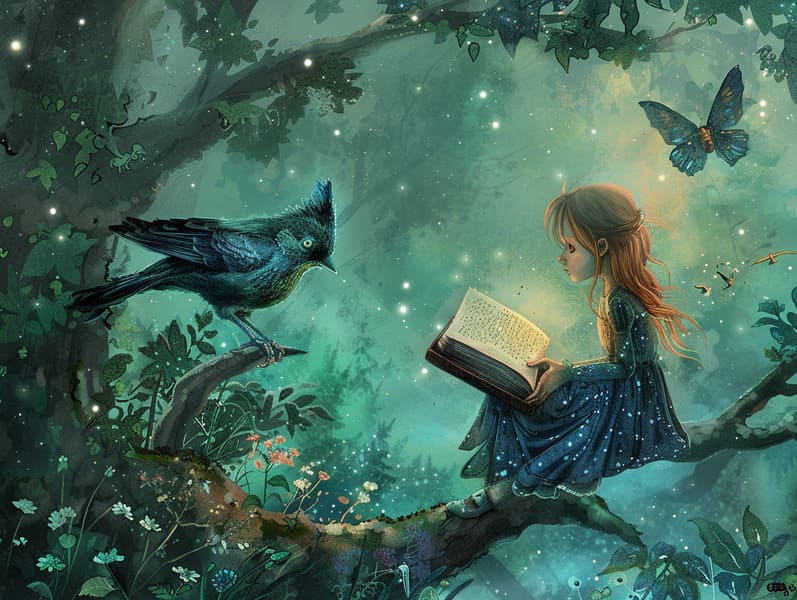The Birth of Traditional Fairy Tales with Their Everlasting Loveliness.

Popular fairy tales have enduring presence. These stories have been told from one generation to the next far before they were ever transcribed. They were born from a variety of societies, including Middle Eastern traditions. They were initially disseminated among mature audiences, often carrying themes and messages mirroring the societal norms and beliefs of the time.
The renowned Brothers Grimm, Jacob and Wilhelm (the Grimm brothers), were among the first to compile many of these beloved stories. Their compilation, "Grimm's Folk Tales," included classics like "The True Bride," "Hansel and Gretel," and "Snow-White and Rose-Red," which have since become essentials in the world of timeless fairy tales. Similarly, H. C. Andersen's whimsical tales, such as "The Sea Maid," and "The Story of the Ugly Duckling," have floated into hearts worldwide, solidifying their place in the pantheon of iconic fairy tales.
Though they are centuries old, fairy tales remain as applicable as ever, especially as kids' bedtime tales. These delightful tales are now available in diverse formats, including gorgeously illustrated books, whimsical animations, and digital storybooks.
Their lasting presence can be connected to several whimsical characteristics:
Crucial Morals: Traditional fairy tales often provide important moral lessons. Stories like "The Shepherd Boy and the Wolf" teach the significance of truth, while "The Race of the Tortoise and the Hare" demonstrate the qualities of steadfastness and humility. These narratives offer little ones clear distinctions between ethical and unethical, building their moral compass in a tender yet profound way.
Compassion and Insight: Timeless fairy tales frequently portray heroines facing problems and hurdles, encouraging young listeners to sympathize with their struggles and encourage their triumphs. For instance, "Beauty and Her Beast" shows us the virtue of appreciating inner worth to comprehend the inner being of a being, nurturing empathy and knowledge.
Cultural Knowledge: Many old fairy tales are rooted in the cultural contexts from which they emerged. Discovering these tales can provide informative snapshots into different heritages, advancing a sense of global insight and appreciation.
Creativity and Fantasy: The whimsical elements in timeless fairy tales—mythical entities—enliven children’s creative dreams. These stories bring readers to mythical realms, kindling fantasy-filled thoughts and a sense of enchantment that remains a lifetime.
Classic fairy tales are not only delightful but also teaching. They function as magical tools in fostering various mental and emotional abilities in little ones. When traditional fairy tales are spoken, they strengthen communication skills by showing new linguistic elements and sophisticated sentence structures. This practice also fosters hearing perception and concentration, as the young listen intently, expectant to see what happens next.
Furthermore, reflecting on the themes and characters of traditional fairy tales can foster logical thinking and critical thinking. Young ones are led to detect patterns, forecast, and make sense of cause and effect. These explorations also advance young readers reveal their thoughts and feelings, cultivating their emotional intelligence.
In today’s digital era, the abundance of online storybooks has made these fairy tales more acquirable than ever. Web-based platforms and software offer huge assortments of ancient fairy tales that can be browsed or played anytime, anywhere. Fairy tales spoken get more info are particularly prevalent, presenting an delightful method for young ones to appreciate these entrancing tales. Audiobooks and spoken videos guide characters and settings to life, often supplemented by spellbinding sound effects and harmonies that elevate the narrative journey.
The unending appeal of traditional fairy tales lies in their ability to modify to the present while retaining their essential themes. Contemporary revisions of these stories often show more diverse figures and modern settings, making them relatable to today’s audience. However, the underlying themes of boldness, humanity, and fairness remain unchanged, continuing to affect readers of all ages.
Old fairy tales also offer a sense of contentment and predictability. They deliver up a systematic narrative with a clear beginning, middle, and end, often ending with the termination of conflicts and the triumph of right over wrong. This certainty can be calming for young readers, extending a sense of sturdiness in an fluctuating world.
Classic fairy tales continue to charm and train new generations, maintaining their attraction and value in modern society. As kids' bedtime tales, they offer a perfect blend of charm and enlightenment, nourishing moral values, empathy, and creativity. The presence of online storybooks and the well-liked nature of fairy tales voiced certify that these old narratives remain accessible to new generations.
By defending and broadcasting these stories, we continue to appreciate the rich tapestry of fables and cultural heritage. Whether you are viewing a vividly illustrated book, experiencing a internet collection, or playing an sound book, the captivation of famous fairy tales is always within reach. These narratives show us of the unending power of fairy tales and its ability to unify us across epochs and places.
Regardless if you are experiencing a richly illustrated book, discovering a internet library, or listening on an voice book, the fascination of popular fairy tales is always within reach.
These narratives remind us of the timeless effect of stories and its ability to link us across centuries and lands, weaving a spell that enchants and educates alike.